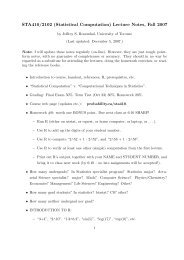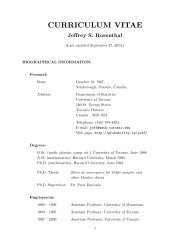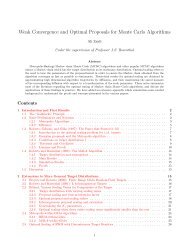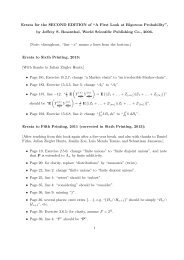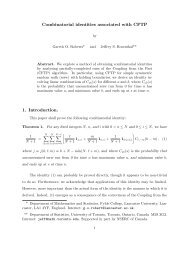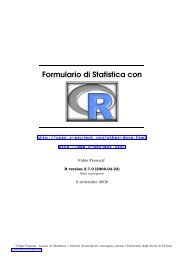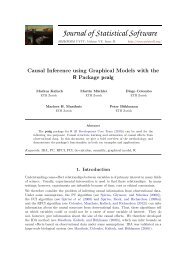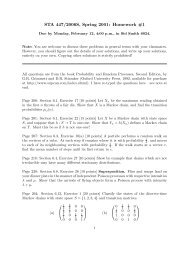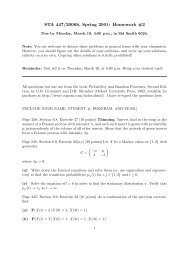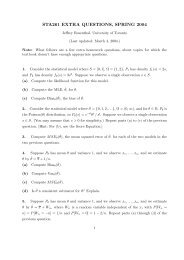Package 'extRemes' - What are R and CRAN?
Package 'extRemes' - What are R and CRAN?
Package 'extRemes' - What are R and CRAN?
Create successful ePaper yourself
Turn your PDF publications into a flip-book with our unique Google optimized e-Paper software.
38 fevd<br />
PrX 0, scale > 0, <strong>and</strong> x > threshold. If shape = 0, then the GP df<br />
is defined by continuity <strong>and</strong> becomes<br />
F(x) = 1 - exp(-(x - threshold)/scale).<br />
There is an approximate relationship between the GEV <strong>and</strong> GP distribution functions where the<br />
GP df is approximately the tail df for the GEV df. In particular, the scale parameter of the GP is a<br />
function of the threshold (denote it scale.u), <strong>and</strong> is equivalent to scale + shape*(threshold - location)<br />
where scale, shape <strong>and</strong> location <strong>are</strong> parameters from the “equivalent” GEV df. Similar to the GEV<br />
df, the shape parameter determines the tail behavior, where shape = 0 gives rise to the exponential<br />
df (light tail), shape > 0 the P<strong>are</strong>to df (heavy tail) <strong>and</strong> shape < 0 the Beta df (bounded upper tail at<br />
location - scale.u/shape). Theoretical justification supports the use of the GP df family for modeling<br />
excesses over a high threshold (i.e., y = x - threshold). It is assumed here that x, q describe x (not y<br />
= x - threshold). Similarly, the r<strong>and</strong>om draws <strong>are</strong> y + threshold.<br />
If interest is in minima or deficits under a low threshold, all of the above applies to the negative of<br />
the data (e.g., - max(-X_1,...,-X_n) = min(X_1, ..., X_n)) <strong>and</strong> fevd can be used so long as the user<br />
first negates the data, <strong>and</strong> subsequently realizes that the return levels (<strong>and</strong> location parameter) given<br />
will be the negative of the desired return levels (<strong>and</strong> location parameter), etc.<br />
The study of extremes often involves a paucity of data, <strong>and</strong> for small sample sizes, L-moments may<br />
give better estimates than competing methods, but generalized MLE introduced by Martins <strong>and</strong><br />
Stedinger (2000, 2001) may give better estimates than the L-moments for such samples.<br />
Non-stationary models:<br />
The current code does not allow for non-stationary models with L-moments estimation.<br />
For MLE/GMLE <strong>and</strong> Bayesian estimation, linear models for the parameters may be fit using formulas,<br />
in which case the data argument must be supplied. Specifically, the models allowed for a<br />
set of covariates, y, <strong>are</strong>:<br />
location(y) = mu0 + mu1 * f1(y) + mu2 * f2(y) + ...<br />
scale(y) = sig0 + sig1 * g1(y) + sig2 * g2(y) + ...<br />
log(scale(y)) = phi(y) = phi0 + phi1 * g1(y) + phi2 * g2(y) + ...<br />
shape(y) = xi0 + xi1 * h1(y) + xi2 * h2(y) + ...<br />
For non-stationary fitting it is recommended that the covariates within the generalized linear models<br />
<strong>are</strong> (at least approximately) centered <strong>and</strong> scaled (see examples below). It is generally ill-advised to<br />
include covariates in the shape parameter, but there <strong>are</strong> situations where it makes sense.<br />
Non-stationary modeling is accomplished with fevd by using formulas via the arguments: threshold.fun,<br />
location.fun, scale.fun <strong>and</strong> shape.fun. See examples to see how to do this.<br />
Initial Value Estimates:<br />
In the case of MLE/GMLE, it can be very important to get good initial estimates (e.g., see the<br />
examples below). fevd attempts to find such estimates, but it is also possible for the user to supply<br />
their own initial estimates as a list object using the initial argument, whereby the components<br />
of the list <strong>are</strong> named according to which parameter(s) they <strong>are</strong> associated with. In particular, if the<br />
model is non-stationary, with covariates in the location (e.g., mu(t) = mu0 + mu1 * t), then initial<br />
may have a component named “location” that may contain either a single number (in which case,<br />
by default, the initial value for mu1 will be zero) or a vector of length two giving initial values for<br />
mu0 <strong>and</strong> mu1.



